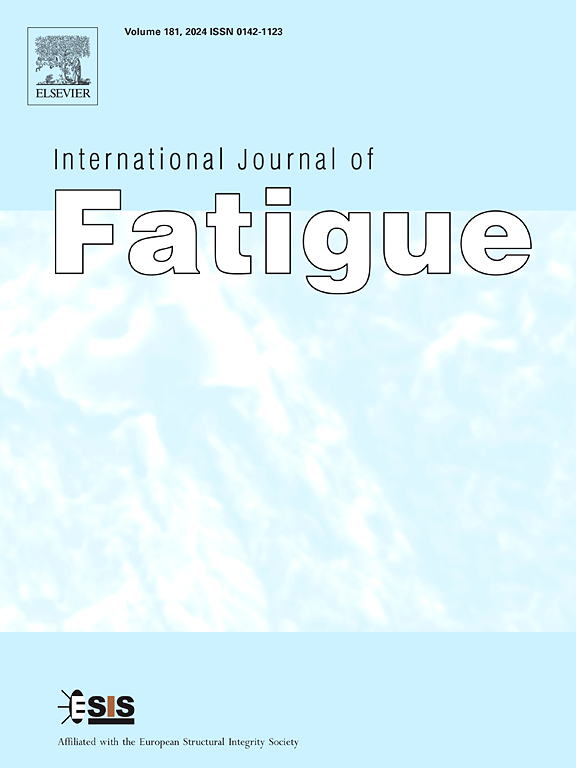The significance of microstructure heterogeneities on the VHCF life of cast aluminum alloys
IF 5.7
2区 材料科学
Q1 ENGINEERING, MECHANICAL
引用次数: 0
Abstract
The very high cycle fatigue (VHCF) of cast aluminum is strongly associated with casting defects and microstructure features, e.g. porosity, (secondary) dendrite arm spacing (SDAS) and intermetallics. Complex components have an inhomogeneous microstructure due to locally varying solidification conditions. Due to complex geometries, directional solidification and sufficient feeding are often not possible, giving rise to solidification defects and shrinkage pores. These microstructural aspects influence the service life, as demonstrated by fatigue tests on automotive engine blocks and cylinder heads. However, understanding the damage process and correlating it with the microstructure is difficult due to the large number of influencing factors and their interdependencies. To this end, laboratory melts with controlled microstructure evolution were used, allowing a variation of SDAS, eutectic Si and pores under otherwise identical boundary conditions. Mechanical resonance and ultrasonic fatigue testing in combination with high-resolution microstructure analysis show a reduction in fatigue life with increasing SDAS. Main reasons are large α-aluminum cells, which provide low resistance to crack propagation. The impact of pores is depending on their size, shape and location. Large fissured pores in near-surface regions act as crack initiators, whereas small spherical pores can retard crack propagation due to crack deflection and crack tip blunting.
组织非均质性对铸铝合金VHCF寿命的影响
铸铝的高周疲劳(VHCF)与铸造缺陷和微观结构特征密切相关,如孔隙率、(次生)枝晶臂间距(SDAS)和金属间化合物。由于局部凝固条件的变化,复杂部件具有不均匀的微观组织。由于复杂的几何形状,定向凝固和充分的喂料往往是不可能的,产生凝固缺陷和收缩孔。正如汽车发动机缸体和气缸盖的疲劳试验所证明的那样,这些微观结构方面会影响使用寿命。然而,由于影响损伤过程的因素众多且相互依赖,因此很难理解损伤过程并将其与微观结构联系起来。为此,使用了控制微观结构演变的实验室熔体,允许在其他相同的边界条件下改变SDAS,共晶Si和孔隙。机械共振和超声疲劳测试结合高分辨率显微组织分析表明,随着SDAS的增加,疲劳寿命降低。主要原因是α-铝晶胞较大,抗裂纹扩展能力较低。孔隙的影响取决于它们的大小、形状和位置。近表面区域的大孔洞是裂纹的起爆点,而小的球形孔洞由于裂纹偏转和裂纹尖端钝化而延缓裂纹扩展。
本文章由计算机程序翻译,如有差异,请以英文原文为准。
求助全文
约1分钟内获得全文
求助全文
来源期刊

International Journal of Fatigue
工程技术-材料科学:综合
CiteScore
10.70
自引率
21.70%
发文量
619
审稿时长
58 days
期刊介绍:
Typical subjects discussed in International Journal of Fatigue address:
Novel fatigue testing and characterization methods (new kinds of fatigue tests, critical evaluation of existing methods, in situ measurement of fatigue degradation, non-contact field measurements)
Multiaxial fatigue and complex loading effects of materials and structures, exploring state-of-the-art concepts in degradation under cyclic loading
Fatigue in the very high cycle regime, including failure mode transitions from surface to subsurface, effects of surface treatment, processing, and loading conditions
Modeling (including degradation processes and related driving forces, multiscale/multi-resolution methods, computational hierarchical and concurrent methods for coupled component and material responses, novel methods for notch root analysis, fracture mechanics, damage mechanics, crack growth kinetics, life prediction and durability, and prediction of stochastic fatigue behavior reflecting microstructure and service conditions)
Models for early stages of fatigue crack formation and growth that explicitly consider microstructure and relevant materials science aspects
Understanding the influence or manufacturing and processing route on fatigue degradation, and embedding this understanding in more predictive schemes for mitigation and design against fatigue
Prognosis and damage state awareness (including sensors, monitoring, methodology, interactive control, accelerated methods, data interpretation)
Applications of technologies associated with fatigue and their implications for structural integrity and reliability. This includes issues related to design, operation and maintenance, i.e., life cycle engineering
Smart materials and structures that can sense and mitigate fatigue degradation
Fatigue of devices and structures at small scales, including effects of process route and surfaces/interfaces.
 求助内容:
求助内容: 应助结果提醒方式:
应助结果提醒方式:


